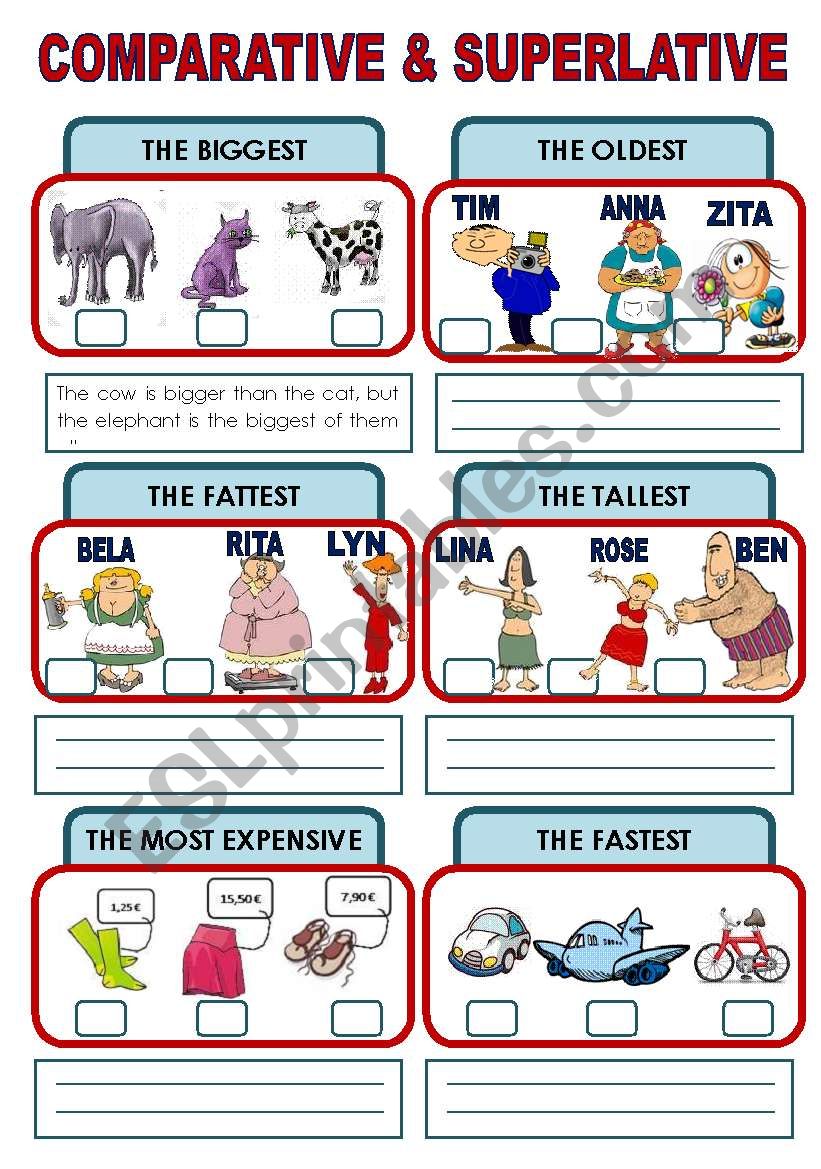
Unlocking Descriptive Language: A Guide to Comparative and Superlative for Grade 1 Worksheets
For young learners embarking on their linguistic journey, mastering descriptive language is a crucial step. It allows them to articulate their observations, compare objects, and express preferences with greater precision. Among the foundational elements of descriptive grammar are comparatives and superlatives. While they might sound complex, introducing these concepts at an early age, particularly in Grade 1, lays a robust groundwork for future language development. This article will delve into the importance of teaching comparative and superlative forms to first graders and highlight how well-designed comparative and superlative for grade 1 worksheets can serve as invaluable tools in this educational endeavor.
The Foundation: Understanding Comparatives and Superlatives for Young Minds
At its core, grammar helps us make sense of language. For a Grade 1 student, abstract grammatical rules can be overwhelming. Therefore, the introduction of comparatives and superlatives must be highly visual, hands-on, and relatable.

- Comparatives: These are used when comparing two things. They typically involve adding "-er" to an adjective (e.g., "bigger," "taller," "faster") or using the word "more" (e.g., "more beautiful," "more interesting"). The key concept for a first grader is "this one versus that one."
- Superlatives: These are used when comparing three or more things, or when identifying the one that stands out from a group. They usually involve adding "-est" to an adjective (e.g., "biggest," "tallest," "fastest") or using the word "most" (e.g., "most beautiful," "most interesting"). For young children, this translates to "the one that is the most [adjective] out of all of them."


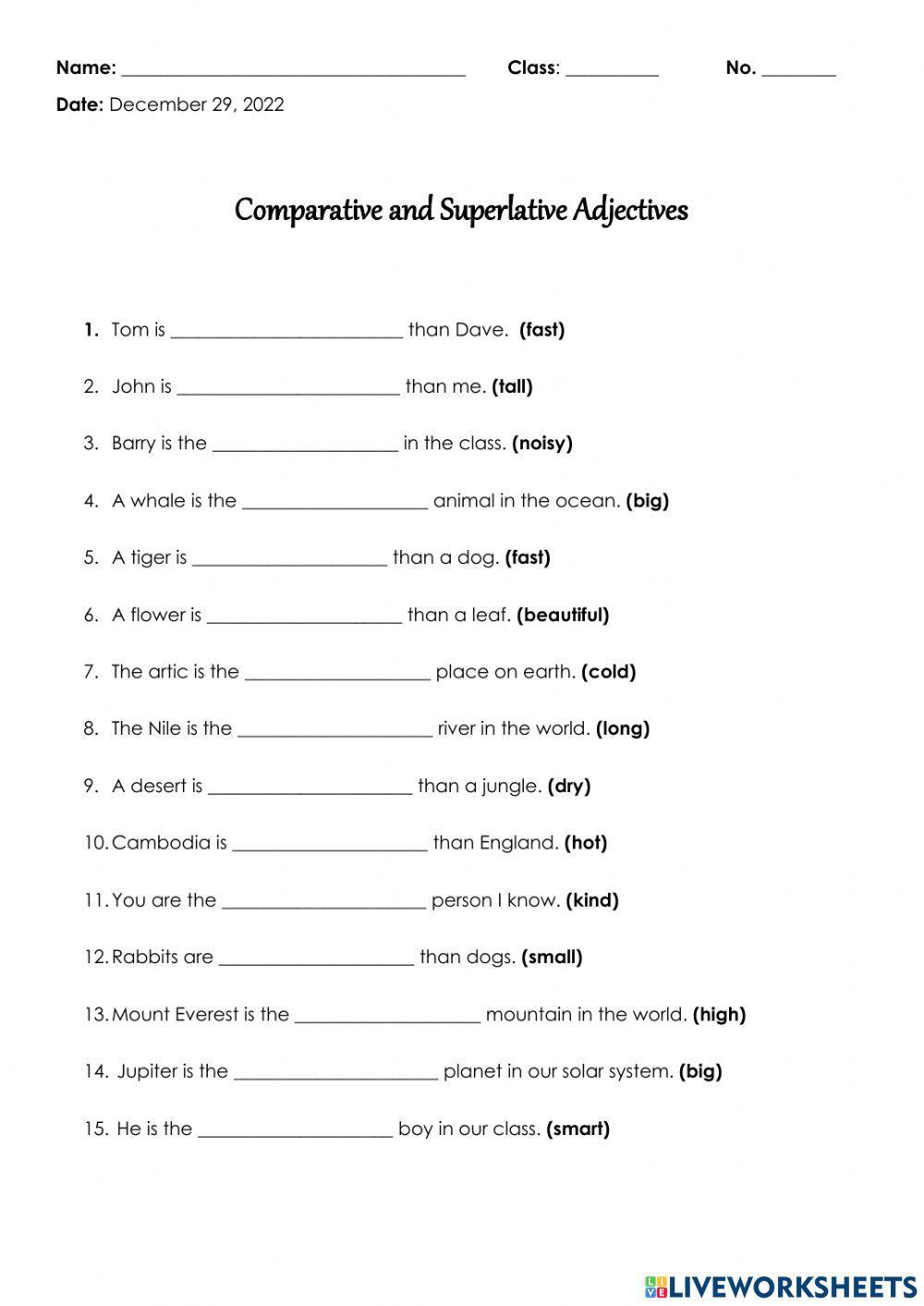
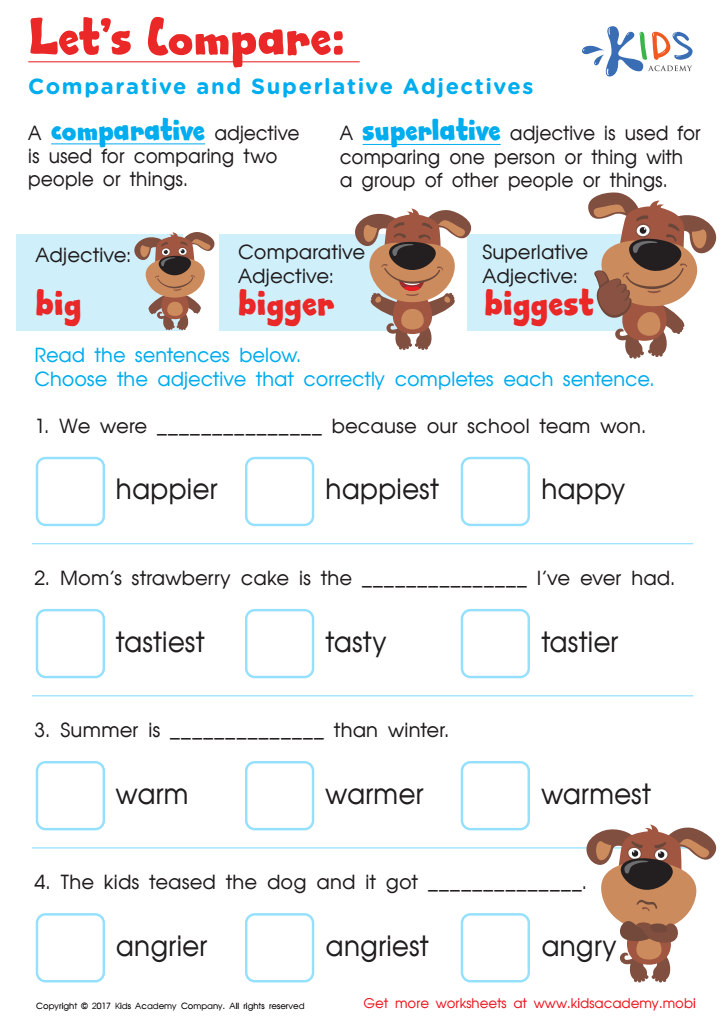
The goal isn’t rote memorization of rules, but rather an intuitive understanding of when and how to use these forms to describe the world around them.
Why Teach Comparatives and Superlatives in Grade 1?
Introducing these concepts early offers several significant benefits for young learners:
- Enhances Observational Skills: By prompting children to compare and contrast, they become more attentive to details like size, speed, height, and various qualities of objects and people.
- Boosts Vocabulary and Descriptive Power: Learning comparative and superlative forms naturally expands a child’s descriptive vocabulary. Instead of just saying "big," they can say "bigger" or "biggest," adding nuance to their expressions.
- Improves Communication Clarity: When a child can articulate that "my toy car is faster than yours," or "that’s the tallest building I’ve ever seen," their communication becomes more precise and effective.
- Strengthens Reading Comprehension: As children encounter these forms in books and stories, a prior understanding helps them grasp the full meaning of sentences and narratives. They can better understand relationships between characters or objects described in text.
- Builds a Foundation for Advanced Grammar: Early exposure makes subsequent grammar lessons less daunting. It familiarizes them with word transformations and the concept of adjectives modifying nouns based on comparison.
- Fosters Critical Thinking: Deciding whether something is "bigger" or "biggest" requires a simple form of analytical thinking, comparing elements within a given context.
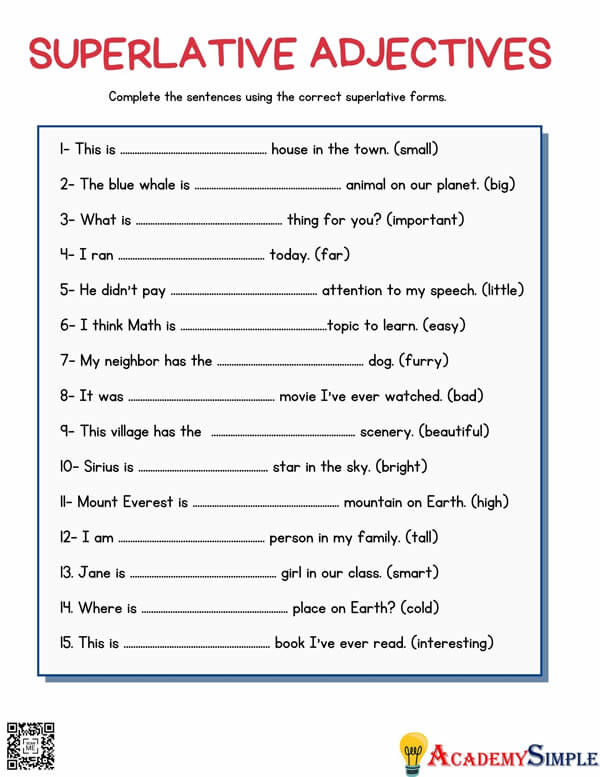


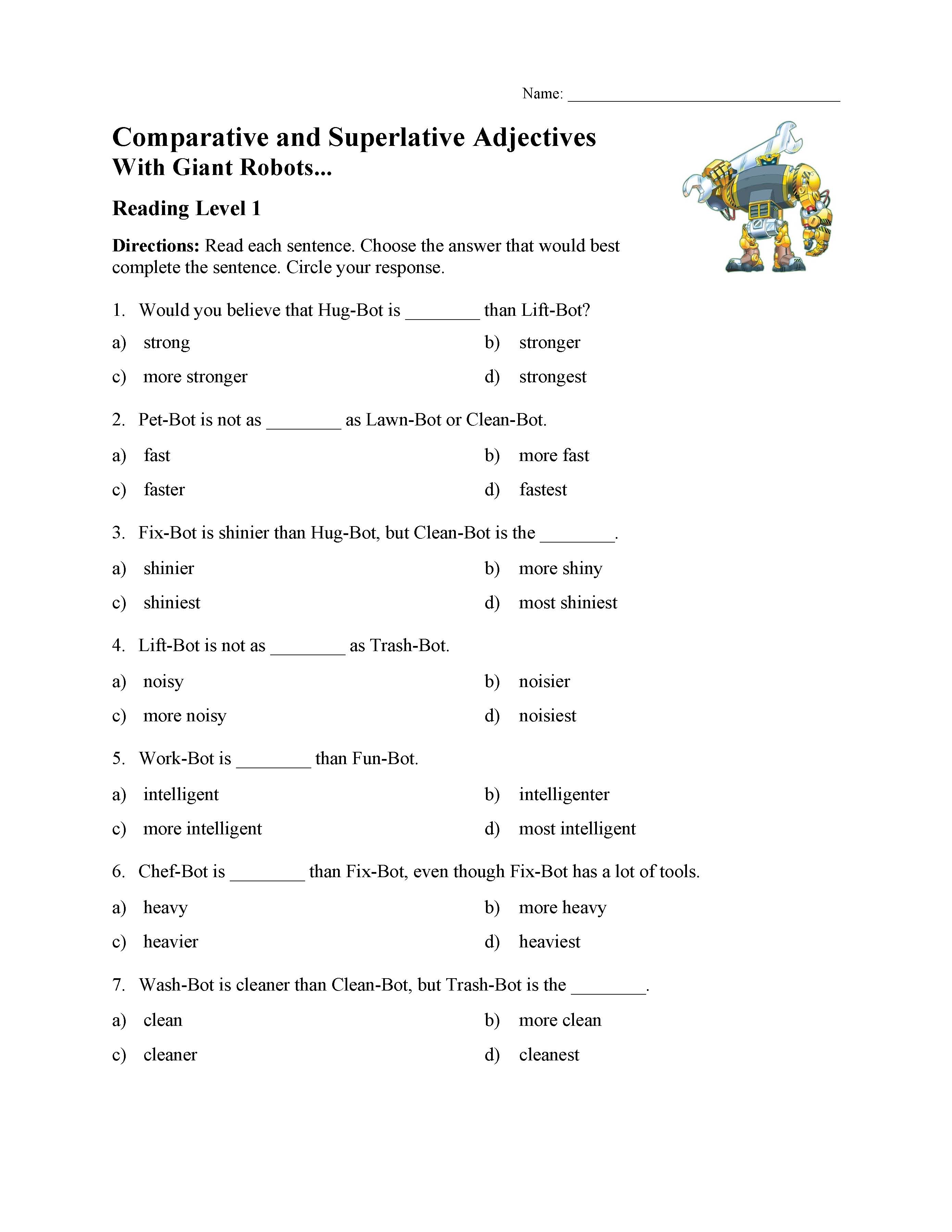
Strategies for Introducing Comparatives and Superlatives Beyond Worksheets
While comparative and superlative for grade 1 worksheets are invaluable for practice, the initial introduction should be hands-on and experiential.
- Real-World Comparisons: Use everyday objects. "Which apple is bigger? Which block is smaller? Who is the tallest in our class?"
- Visual Aids: Pictures of animals (e.g., a mouse, a cat, an elephant to demonstrate small, smaller, smallest), vehicles, or buildings are excellent for illustrating these concepts.
- Storytelling and Read-Alouds: Point out comparative and superlative adjectives as you read. "Look, the bear was bigger than the fox! And the giant was the biggest of all!"
- Movement and Games:
- "Simon Says" with Comparisons: "Simon says take the biggest step." "Simon says hop faster than your friend."
- Object Sorting: Give children a collection of items (e.g., pencils of different lengths, stones of various sizes) and ask them to arrange them from "short to shortest" or "small to smallest."
- Drawing and Art: Ask children to draw "a big house, a bigger house, and the biggest house."
These interactive methods create a concrete understanding before transitioning to more structured learning.
The Role of Comparative and Superlative for Grade 1 Worksheets
Once children have a basic grasp through hands-on activities, this is where well-designed comparative and superlative for grade 1 worksheets become invaluable. They provide a structured environment for practice, reinforcement, and independent application of the learned concepts. Worksheets bridge the gap between abstract understanding and concrete application.
Worksheets allow for:
- Repetitive Practice: Repetition is key for young learners to internalize new concepts.
- Independent Application: Children can apply what they’ve learned without constant direct instruction.
- Assessment: Teachers and parents can gauge a child’s understanding and identify areas needing more attention.
- Reinforcement of Vocabulary: Worksheets often introduce new adjectives in the comparative and superlative forms.
Designing Effective Comparative and Superlative for Grade 1 Worksheets
Creating effective comparative and superlative for grade 1 worksheets requires a thoughtful approach, keeping the developmental stage of first graders in mind.
- Visual Dominance: Pictures are paramount. Each question or exercise should be accompanied by clear, engaging illustrations that directly depict the comparison. For example, three progressively sized animals for "big, bigger, biggest."
- Simple, Clear Instructions: Use concise language that a Grade 1 student can easily understand. "Circle the biggest," "Draw a line from the picture to the word."
- Focus on Common Adjectives: Start with adjectives that are familiar and easy to visualize:
- Size: big, small, tall, short, long
- Speed: fast, slow
- Age: old, young
- Emotions: happy, sad
- Quantity: many, few (though "more/most" might be introduced later as irregular forms)
- Variety of Exercise Types:
- Picture Matching: Match a picture of three items (e.g., a small apple, a medium apple, a large apple) to the words "small," "smaller," "smallest."
- Circle the Correct Word: Given a picture showing two items, circle "bigger" or "smaller." Given three items, circle "biggest" or "smallest."
- Fill-in-the-Blank with Word Bank: "The cat is __ than the mouse." (Word bank: big, bigger, biggest)
- Drawing Activities: "Draw a car that is faster than this one." "Draw the tallest tree in the forest."
- Cut and Paste: Cut out words or pictures and paste them into the correct comparative or superlative column.
- Gradual Complexity: Start with simple "-er" and "-est" forms. Introduce irregular forms (good/better/best, bad/worse/worst) and "more/most" adjectives (e.g., "beautiful") later, once the basic concept is solid.
- Engaging Themes: Incorporate themes that appeal to first graders: animals, toys, food, nature, superheroes, etc. This makes the learning process more enjoyable.
- Limited Text: Keep the amount of reading text to a minimum, focusing on the visual aspect and the target grammar point.
Examples of Worksheet Activities for Grade 1
Here are some specific ideas for comparative and superlative for grade 1 worksheets:
- Activity 1: "Size Sort"
- Concept: Big, bigger, biggest / Small, smaller, smallest
- Worksheet: Three columns labeled "Big," "Bigger," "Biggest." Provide cut-out pictures of three objects of varying sizes (e.g., three different sized elephants, three different sized balls). Children cut and paste each picture into the correct column.
- Activity 2: "Fastest Race"
- Concept: Fast, faster, fastest / Slow, slower, slowest
- Worksheet: Pictures of three animals or vehicles (e.g., a snail, a turtle, a rabbit for slow/slower/slowest; a bicycle, a car, a plane for fast/faster/fastest). Sentences with blanks: "The snail is __. The turtle is __ than the snail. The rabbit is the __ animal." (Word bank: slow, slower, slowest).
- Activity 3: "Happy Faces"
- Concept: Happy, happier, happiest / Sad, sadder, saddest
- Worksheet: Three cartoon faces showing different levels of happiness or sadness. "Circle the happier face." "Draw the happiest face you can imagine."
- Activity 4: "Tall Buildings"
- Concept: Tall, taller, tallest / Short, shorter, shortest
- Worksheet: A drawing of three buildings of different heights. Questions like: "Which building is the tallest? Circle it." "Draw a building that is shorter than this one."
- Activity 5: "Comparing Objects"
- Concept: Mixed adjectives
- Worksheet: Pairs of objects (e.g., two pencils of different lengths, two books of different weights). Sentences: "The red pencil is __ than the blue pencil." (long/longer/longest). "The big book is __ than the small book." (heavy/heavier/heaviest).
Integrating Worksheets with Broader Learning
Comparative and superlative for grade 1 worksheets should not exist in isolation. They are most effective when integrated into a holistic language learning approach.
- Pre-Worksheet Discussion: Before handing out a worksheet, review the concepts orally and with physical objects.
- Post-Worksheet Review: Go over the answers together as a class or individually, providing immediate feedback.
- Extension Activities: After completing a worksheet, encourage children to create their own comparative sentences orally or by drawing. "Can you tell me something that is bigger than your shoe?"
- Real-World Application: Continually point out and use comparative and superlative forms in everyday conversations. "Your tower is getting taller! Is it the tallest one we’ve built today?"
By combining these strategies with engaging comparative and superlative for grade 1 worksheets, educators and parents can provide a comprehensive learning experience that not only teaches grammar rules but also fosters a deeper appreciation for the nuances of language.
Addressing Common Challenges and Irregular Forms
While Grade 1 focuses on the basics, it’s important to be aware of potential challenges:
- Over-Generalization: Children might try to apply "-er" and "-est" to all adjectives, even irregular ones (e.g., "gooder," "most good"). Gently correct and introduce the correct irregular forms (good, better, best; bad, worse, worst; many/much, more, most) through repetition and examples, rather than complex rules.
- Adjectives Ending in ‘y’: Explain simply that for words like "happy," the ‘y’ changes to ‘i’ before adding "-er" or "-est" (happier, happiest). Visual examples help here.
- One-Syllable vs. Multi-Syllable Adjectives: While the rule about "more/most" for longer adjectives (e.g., "beautiful," "important") isn’t explicitly taught as a rule in Grade 1, it can be introduced naturally. "We say ‘more beautiful,’ not ‘beautifuler’." Use common examples.
Patience and consistent, gentle correction within a supportive environment are key. The goal is exposure and comfort with the forms, not perfect mastery of every rule.
The Lasting Benefits of Early Comparative and Superlative Mastery
Ultimately, the goal of using comparative and superlative for grade 1 worksheets is to make learning fun, accessible, and effective, setting children up for future academic success. When children grasp these concepts early, they gain:
- Richer Writing: Their written narratives and descriptions become more vivid and precise.
- Stronger Oral Communication: They can express complex ideas and observations with greater clarity.
- Enhanced Analytical Skills: The act of comparing and contrasting is a fundamental building block of critical thinking.
- Increased Confidence: Successfully using descriptive language empowers children in their communication.
In essence, comparative and superlative for grade 1 worksheets are more than just exercises; they are tools that solidify understanding, build confidence, and open up a world of descriptive possibilities for young learners. By making grammar engaging and relevant, we equip children with the linguistic tools they need to articulate their unique perspectives and interact with the world around them more effectively.
